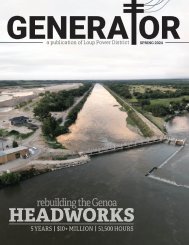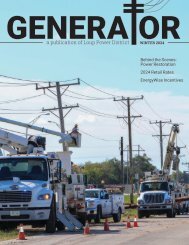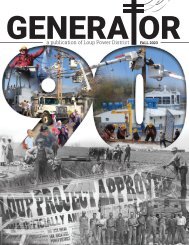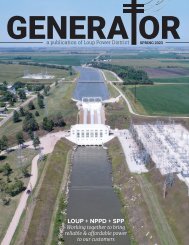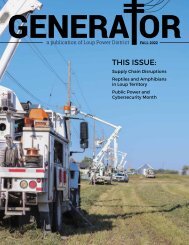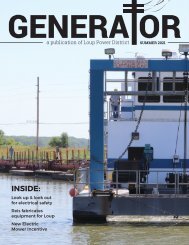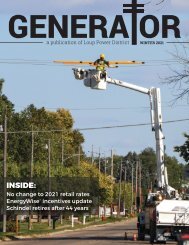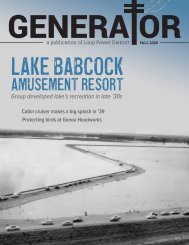Generator—Summer 2022
In this edition: A Californian retraces Horatio's Drive and the Lincoln Highway in a 1964 Volkswagon Bus converted to run on electricity; an underwater inspection at the Monroe Powerhouse; summer safety tips; and more.
In this edition: A Californian retraces Horatio's Drive and the Lincoln Highway in a 1964 Volkswagon Bus converted to run on electricity; an underwater inspection at the Monroe Powerhouse; summer safety tips; and more.
Create successful ePaper yourself
Turn your PDF publications into a flip-book with our unique Google optimized e-Paper software.
UNDERWATER<br />
INSPECTION<br />
The Columbus and Monroe powerhouses<br />
are impressive structures.<br />
But they are more than 80 years old and<br />
need regular tending. The employees who<br />
work there every day spot mechanical and<br />
structural issues on the inside and outside.<br />
But what about under?<br />
That’s where things get a little more<br />
tricky.<br />
There are trash rack supports under the<br />
water on the upstream side of the Monroe<br />
Powerhouse (MPH). These racks prevent<br />
debris from entering the generator turbines<br />
and regulating wicket gates.<br />
Last year, employees noticed<br />
that the wear plates that protect<br />
these supports were deteriorating and<br />
needed maintenance.<br />
Accessing underwater areas of the<br />
canal is no easy task, however. That’s why<br />
the MPH trash racks and supports had not<br />
been inspected in almost 20 years.<br />
In May, Loup employees completed<br />
the task with the assistance of a diver and<br />
crane team.<br />
The project was scheduled for that time<br />
because Loup could lower the upstream<br />
water level without affecting canal irrigators.<br />
After clearing the<br />
debris, the location<br />
was dewatered using<br />
bulkheads (stop logs) to<br />
seal off the canal.<br />
Each of the two generator<br />
intakes is divided into<br />
two sections. Each<br />
requires three stop logs<br />
stacked on top of each<br />
other to provide a safe<br />
barrier between the canal<br />
and the work area.<br />
Once the stop logs were installed and<br />
each section was dewatered (above),<br />
the trash rack sections were removed<br />
(left) with the help of a crane. The racks<br />
were tagged, cleaned, and inspected.<br />
Top: Kenny Ferris with Husker Marine of Burwell prepares to check for debris at the powerhouse.<br />
Above left: Lance Ferris, Canal Lead, and Brad Morton, Hydro Superintendent, monitor the dive<br />
from the powerhouse deck.<br />
Above middle: Lance Ferris (right) helps Kenny Ferris replace his oxygen tank.<br />
Right: A log is removed from the bottom of the canal after being discovered by the diver.<br />
Photos by Brad Morton, Lance Ferris, and Stacy Wemhoff.<br />
After the racks are removed, the support structure<br />
is inspected (right) and repaired as needed (above).<br />
Then the racks are reinstalled, the stop logs are<br />
removed to allow water back into the scroll case,<br />
and the generator is placed back into service.<br />
10 | GENERATOR SUMMER <strong>2022</strong> | 11



